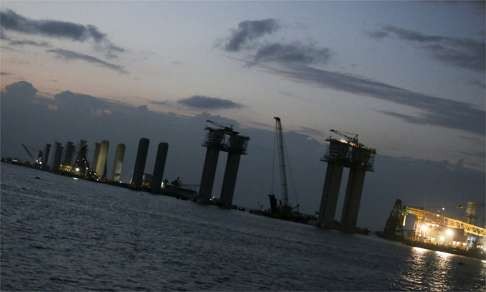
Experts blame Hong Kong-Zhuhai-Macau Bridge for falling dolphin numbers
They also say that construction of the third airport runway will result in more loss, and urge the government to designate more marine parks

The number of Chinese white dolphins has dropped from 25 to just 10 in the northern waters of Lantau in the past year, with marine experts identifying the construction of the Hong Kong-Zhuhai-Macao Bridge as the main culprit.
According to figures acquired by WWF Hong Kong from a not yet released Agriculture, Fisheries and Conservation Department (AFCD) report - between April 2015 and March 2016, the total estimated number of white dolphins in Hong Kong dropped by a quarter from 87 to 65.
Dolphins found in the northern waters of Lantau were worst hit, with numbers dropping by 60 per cent in this period. This area had been most affected by construction. For example, the once prime dolphin waters around Mo To Chau - two islands to the north of Hong Kong International Airport - are now adjacent to a man-made island reclaimed for the bridge.
“The report is shocking and has set off alarm bells,” Samantha Lee, conservation expert at WWF Hong Kong, said. She attributed the sudden drop in numbers to the construction of the bridge and was also worried about the impending construction of the airport’s third runway, which would involve more ships and undersea noise.
Samuel Hung Ka-yiu, Chairman of the Hong Kong Dolphin Conservation Society - who was commissioned by the AFCD to compile the report - declined to comment on its figures.
However, he attributed the dropping dolphin numbers in the past few years to a combination of habitat loss, reclamation and increasing high-speed ferry traffic in the area.
“The construction of the airport’s third runway would be a huge blow to their survival,” Hung said. “This is clear from the building of the bridge, which already required much less reclamation than the airport.”
The AFCD explained to the Post that the decreasing number of dolphins in northern Lantau were due to the animals’ migration into western and southern Lantau waters as well as mainland territory.
Both the WWF and Hung agreed on the need to establish more marine parks. “We urge the government to establish a west Lantau marine park off the shore of Tai O,” Lee said. This would create a safe travelling corridor for dolphins from northern Lantau.
There are currently four marine parks in Hong Kong. However, dolphins are only found in one - the 1,200-hectare Sha Chau and Lung Kwu Chau Marine Park in northern Lantau.
The government plans to designate three more marine parks - one in southwest Lantau and one near the Soko Islands by 2017, as well as another near Mo To Chau later this year. In total they will cover around 2,900 hectares of prime dolphin territory.
But Hung believed these new parks will not be large enough to compensate for the habitat loss caused by the third runway.
Moreover, Lee was concerned that the Sha Chau and Lung Kwu Chau Marine Park, designated in 1996, was no longer able to fend off the multitude of threats currently facing dolphins. According to marine experts who spoke at the AFCD’s Marine Mammal Conservation Working Group meeting on Friday, the number of dolphin calves was at a historic low.